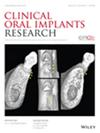一种新型的微/纳米粗糙自釉面氧化锆种植体,具有增强骨整合和满意的软组织密封:体外和体内研究
IF 5.3
1区 医学
Q1 DENTISTRY, ORAL SURGERY & MEDICINE
引用次数: 0
摘要
目的制备一种新型自釉面氧化锆(SZr)牙种植体,并对其进行体外和体内性能研究。材料与方法采用喷砂和化学气相沉积法制备了微纳粗化SZr表面(SZr - MN)。系统地表征了表面形貌、元素组成、粗糙度和接触角。用变形链球菌和牙龈卟啉单胞菌评价细菌粘连。骨髓间充质干细胞(BMSCs)和人永生化角质形成细胞被用来评估细胞粘附、增殖和成骨分化。喷砂大粒度酸蚀处理的钛(Ti)表面(Ti - SLA)作为对照。将Ti和SZr植入Beagle犬下颌骨,在愈合8周和12周后进行放射学、荧光学和组织形态学分析。结果SZr - MN表面呈现出微尺度的沟壑和沟壑,这些沟壑和沟壑被卷曲的片状纳米结构密集覆盖,这使得SZr - MN表面具有良好的粗糙度和亲水性。与Ti - SLA表面相比,SZr - MN表面显示出明显减少细菌粘附,同时增加BMSCs的粘附和成骨分化。因此,与钛种植体相比,SZr种植体获得了更广泛和更密集的周围骨组织,并增强了骨整合,同时两者都显示出相似的种植体周围软硬组织尺寸。结论新型SZr种植体表面具有良好的抗菌活性、生物相容性和成骨作用,可促进骨整合和软组织密封。我们的研究结果为提高氧化锆种植体的生物活性提供了一个独特的视角。本文章由计算机程序翻译,如有差异,请以英文原文为准。
A Novel Micro/Nano‐Roughened Self‐Glazed Zirconia Implant With Enhanced Osseointegration and Satisfactory Soft Tissue Sealing: An In Vitro and In Vivo Study
ObjectivesThis study aimed to develop a novel self‐glazed zirconia (SZr) dental implant featuring micro/nano‐roughened thread and polished neck, and to examine its properties both in vitro and in vivo.Material and MethodsThe micro/nano‐roughened SZr surfaces (SZr‐MN) were manufactured using sandblasting and chemical vapor deposition. Surface topography, elemental composition, roughness, and contact angle were systematically characterized. Streptococcus mutans Porphyromonas gingivalis
求助全文
通过发布文献求助,成功后即可免费获取论文全文。
去求助
来源期刊

Clinical Oral Implants Research
医学-工程:生物医学
CiteScore
7.70
自引率
11.60%
发文量
149
审稿时长
3 months
期刊介绍:
Clinical Oral Implants Research conveys scientific progress in the field of implant dentistry and its related areas to clinicians, teachers and researchers concerned with the application of this information for the benefit of patients in need of oral implants. The journal addresses itself to clinicians, general practitioners, periodontists, oral and maxillofacial surgeons and prosthodontists, as well as to teachers, academicians and scholars involved in the education of professionals and in the scientific promotion of the field of implant dentistry.
 求助内容:
求助内容: 应助结果提醒方式:
应助结果提醒方式:


